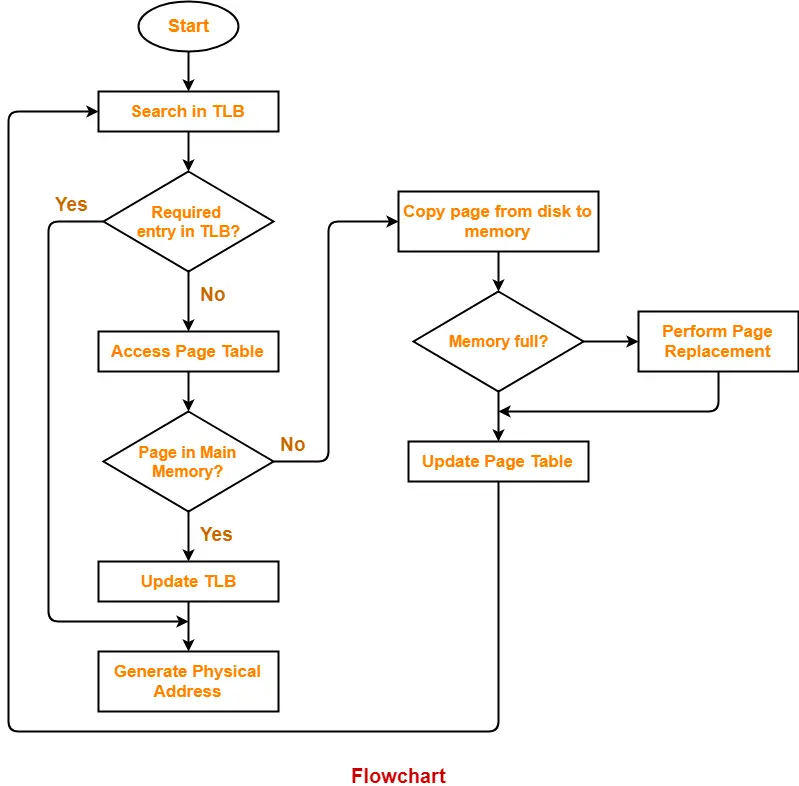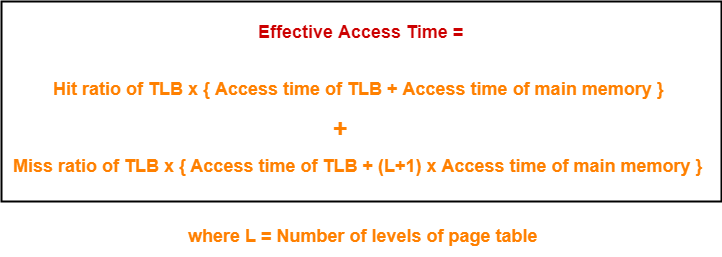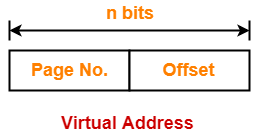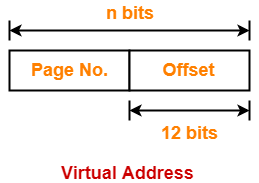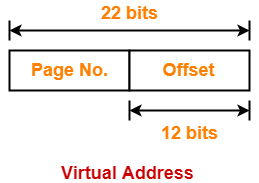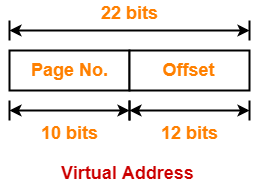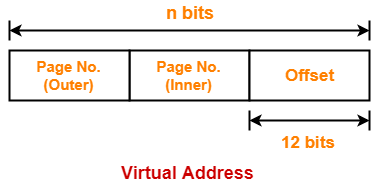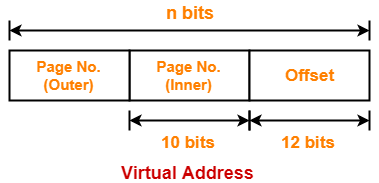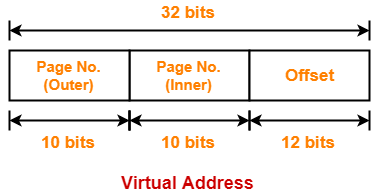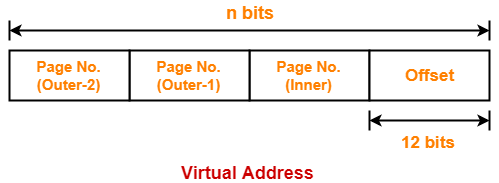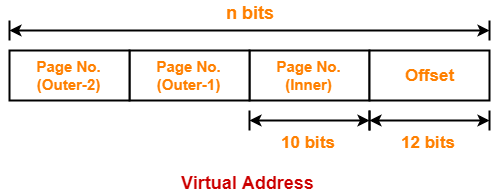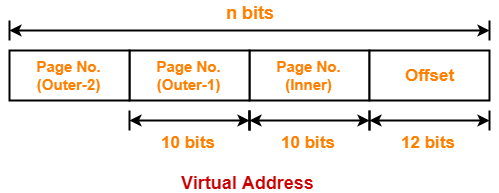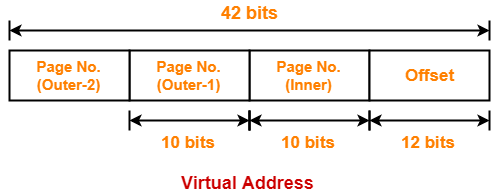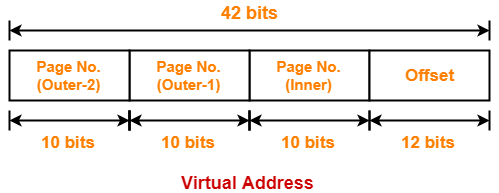Page Fault in OS-
Before you go through this article, make sure that you have gone through the previous article on Page Fault in OS.
We have discussed-
- A page fault occurs when the referenced page is not found in the main memory.
- Page fault handling routine is executed on the occurrence of page fault.
- The time taken to service the page fault is called as page fault service time.
Effective Access time-
In a multilevel paging scheme using TLB without any possibility of page fault, effective access time is given by-
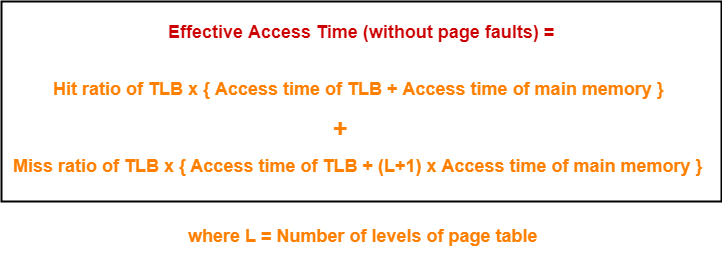
In a multilevel paging scheme using TLB with a possibility of page fault, effective access time is given by-

Also Read- Page Replacement Algorithms
PRACTICE PROBLEMS BASED ON PAGE FAULTS IN OS-
Problem-01:
Let the page fault service time be 10 ms in a computer with average memory access time being 20 ns. If one page fault is generated for every 106 memory accesses, what is the effective access time for the memory?
- 21 ns
- 30 ns
- 23 ns
- 35 ns
Solution-
Given-
- Page fault service time = 10 ms
- Average memory access time = 20 ns
- One page fault occurs for every 106 memory accesses
Page Fault Rate-
It is given that one page fault occurs for every 106 memory accesses.
Thus,
Page fault rate
= 1 / 106
= 10-6
Effective Access Time With Page Fault-
It is given that effective memory access time without page fault = 20 ns.
Now, substituting values in the above formula, we get-
Effective access time with page fault
= 10-6 x { 20 ns + 10 ms } + ( 1 – 10-6 ) x { 20 ns }
= 10-6 x 10 ms + 20 ns
= 10-5 ms + 20 ns
= 10 ns + 20 ns
= 30 ns
Thus, Option (B) is correct.
Problem-02:
Suppose the time to service a page fault is on the average 10 milliseconds, while a memory access takes 1 microsecond. Then, a 99.99% hit ratio results in average memory access time of-
- 1.9999 milliseconds
- 1 millisecond
- 9.999 microseconds
- 1.9999 microseconds
- None of these
Solution-
Given-
- Page fault service time = 10 msec
- Average memory access time = 1 μsec
- Hit ratio = 99.99% = 0.9999
Page Fault Rate-
Page fault rate
= 1 – Hit ratio
= 1 – 0.9999
= 0.0001
Effective Access Time With Page Fault-
It is given that effective memory access time without page fault = 1 μsec.
Substituting values in the above formula, we get-
Effective access time with page fault
= 0.0001 x { 1 μsec + 10 msec } + 0.99999 x 1 μsec
= 0.0001 μsec + 0.001 msec + 0.9999 μsec
= 1 μsec + 0.001 msec
= 1 μsec + 1 μsec
= 2 μsec or 0.002 msec
Thus, Option (E) is correct.
Problem-03:
If an instruction takes i microseconds and a page fault takes an additional j microseconds, the effective instruction time if on the average a page fault occurs every k instruction is-
- i + j / k
- i + j x k
- (i + j) / k
- (i + j) x k
Solution-
Given-
- Page fault service time = j μsec
- Average memory access time = i μsec
- One page fault occurs every k instruction
Page Fault Rate-
It is given that one page fault occurs every k instruction.
Thus,
Page fault rate
= 1 / k
Effective Access Time With Page Fault-
It is given that effective memory access time without page fault = i μsec
Now, substituting values in the above formula, we get-
Effective access time with page fault
= (1 / k) x { i μsec + j μsec } + ( 1 – 1 / k) x { i μsec }
= j / k μsec + i μsec
= i + j / k μsec
Thus, Option (A) is correct.
Problem-04:
Consider a system with a two-level paging scheme in which a regular memory access takes 150 nanoseconds and servicing a page fault takes 8 milliseconds. An average instruction takes 100 nanoseconds of CPU time and two memory accesses. The TLB hit ratio is 90% and the page fault rate is one in every 10,000 instructions. What is the effective average instruction execution time?
- 645 nanoseconds
- 1050 nanoseconds
- 1215 nanoseconds
- 1230 nanoseconds
- None of these
Solution-
Given-
- Number of levels of page table = 2
- Main memory access time = 150 ns
- Page fault service time = 8 msec
- Average instruction takes 100 ns of CPU time and 2 memory accesses
- TLB Hit ratio = 90% = 0.9
- Page fault rate = 1 / 104 = 10-4
Assume TLB access time = 0 since it is not given in the question.
Also, TLB access time is much less as compared to the memory access time.
Effective Access Time Without Page Fault-
Substituting values in the above formula, we get-
Effective memory access time without page fault
= 0.9 x { 0 + 150 ns } + 0.1 x { 0 + (2+1) x 150 ns }
= { 0.9 x 150 ns } + { 0.1 x 450 ns }
= 135 ns + 45 ns
= 180 ns
Effective Access Time With Page Fault-
Substituting values in the above formula, we get-
Effective access time with page fault
= 10-4 x { 180 ns + 8 msec } + (1 – 10-4) x 180 ns
= 8 x 10-4 msec + 180 ns
= 8 x 10-7 sec + 180 ns
= 800 ns + 180 ns
= 980 ns
Effective Average Instruction Execution Time-
Effective Average Instruction Execution Time
= 100 ns + 2 x Effective memory access time with page fault
= 100 ns + 2 x 980 ns
= 100 ns + 1960 ns
= 2060 ns
Thus, Option (E) is correct.
Problem-05:
A demand paging system takes 100 time units to service a page fault and 300 time units to replace a dirty page. Memory access time is 1 time unit. The probability of a page fault is p. In case of a page fault, the probability of page being dirty is also p. It is observed that the average access time is 3 time units. Then the value of p is-
- 0.194
- 0.233
- 0.514
- 0.981
- None of these
Solution-
Given-
- Page fault service time = 100 time units
- Time taken to replace dirty page = 300 time units
- Average memory access time = 1 time unit
- Page fault rate = p
- Probability of page being dirty = p
- Effective access time = 3 time units
Now, According to question-
3 time units = p x { 1 time unit + p x { 300 time units } + (1 – p) x { 100 time units } } + (1 – p) x { 1 time unit }
3 = p x { 1 + 300p + 100 – 100p } + (1 – p)
3 = p x { 101 + 200p } + (1 – p)
3 = 101p + 200p2 + 1 – p
3 = 100p + 200p2 + 1
200p2 + 100p – 2 = 0
On solving this quadratic equation, we get p = 0.019258
Thus, Option (E) is correct.
Next Article- Belady’s Anomaly
Get more notes and other study material of Operating System.
Watch video lectures by visiting our YouTube channel LearnVidFun.
